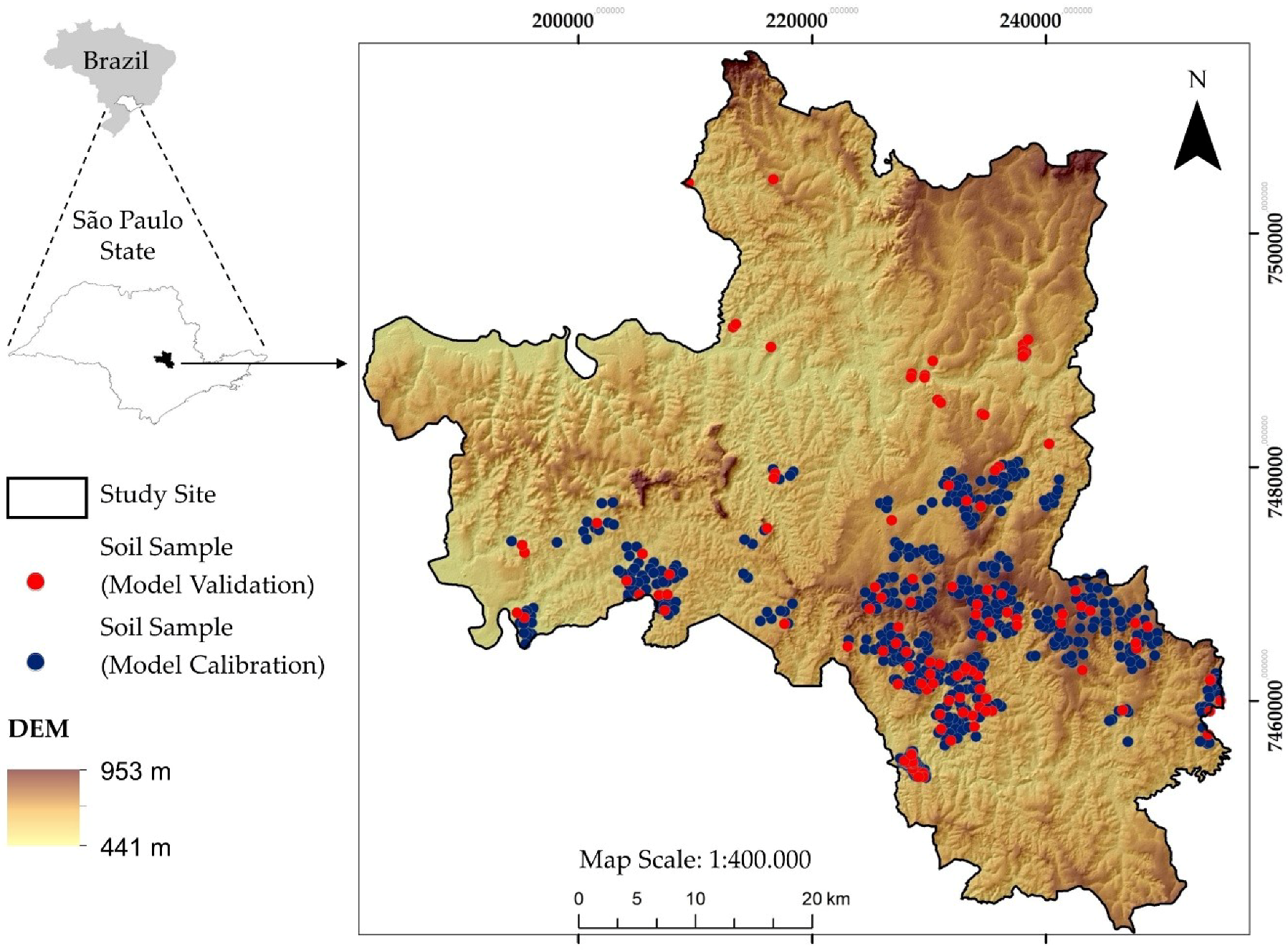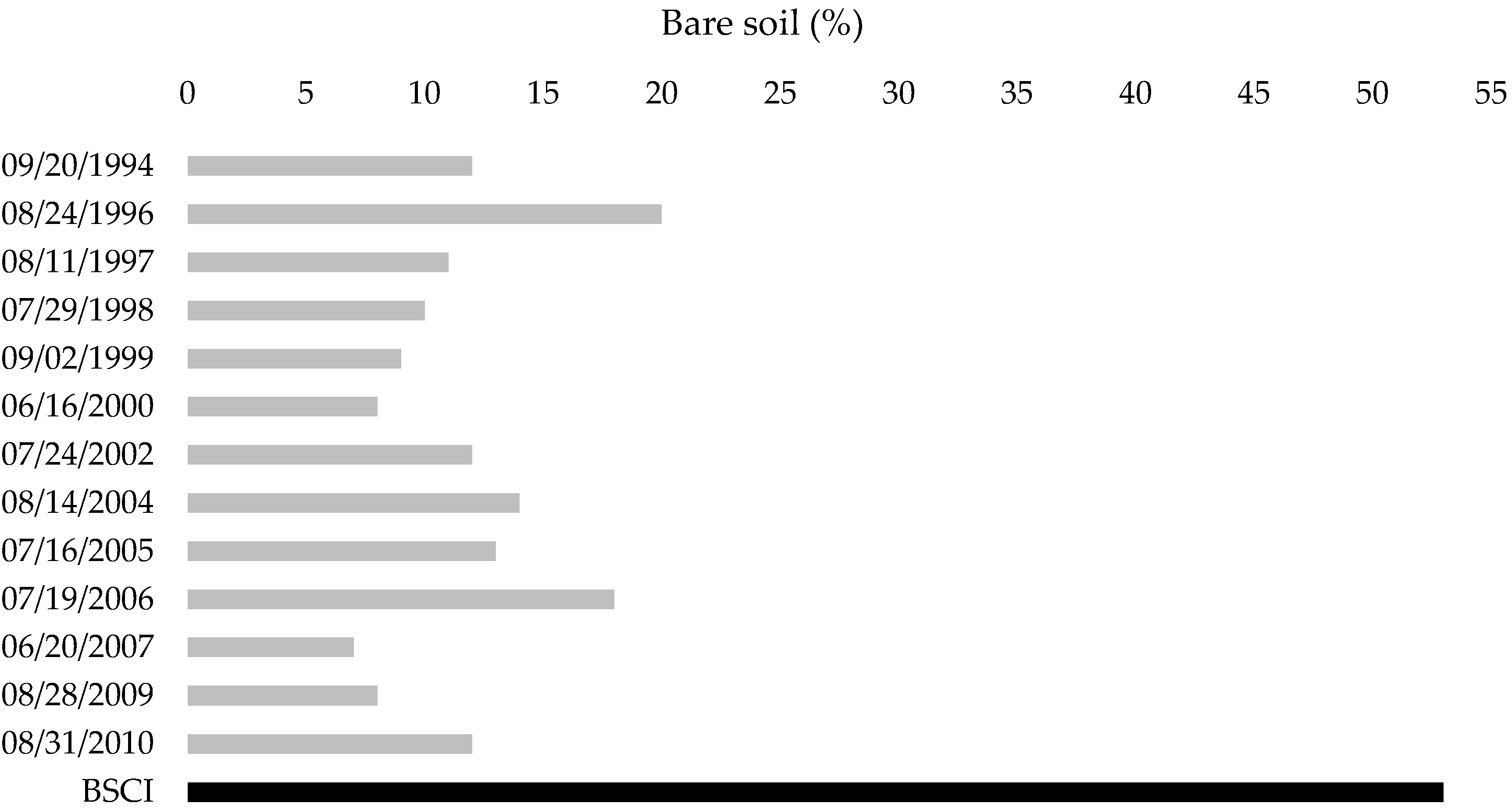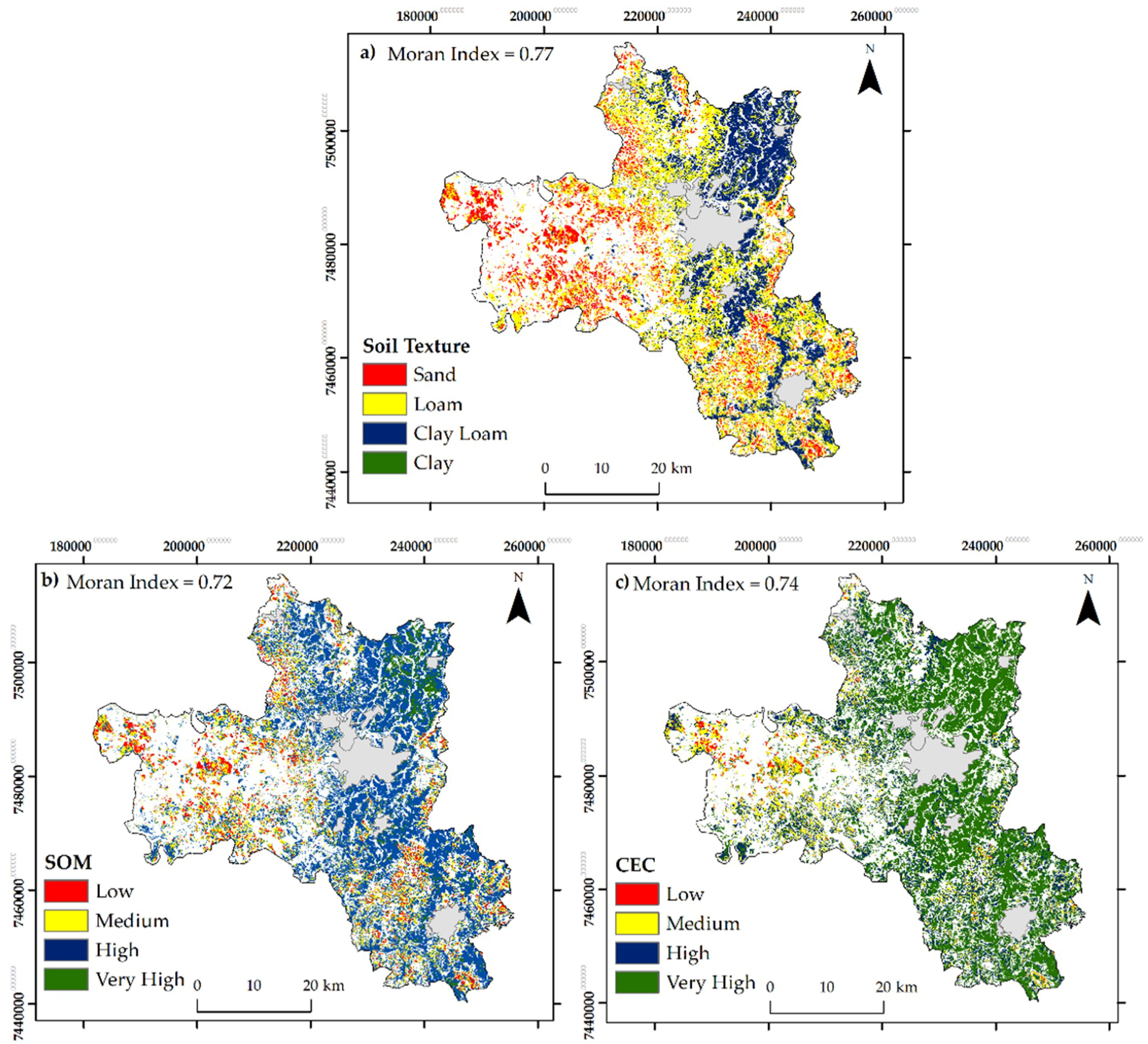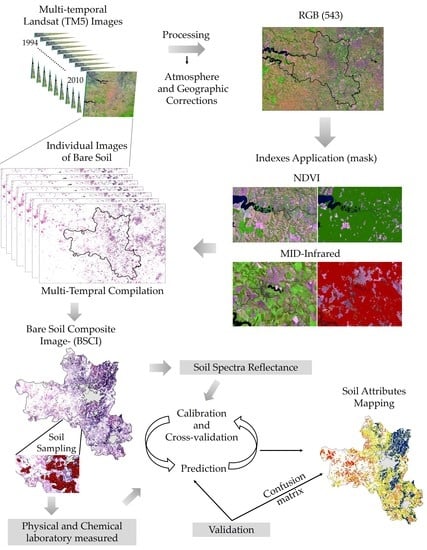Multi-Temporal Satellite Images on Topsoil Attribute Quantification and the Relationship with Soil Classes and Geology
Abstract
:1. Introduction
2. Materials and Methods
2.1. Study Site and Soil Samples
2.2. Multi-Temporal BSCI
2.2.1. Image Acquisition
2.2.2. Image Preprocessing
2.2.3. Soil Masking
2.2.4. Design of BSCI
2.2.5. Evaluation of the BSCI
2.3. Soil Attribute Modeling
3. Results and Discussion
3.1. Soil Characterization
3.2. Multi-Temporal Bare Soil Detection
3.3. BSCI
3.3.1. Bare Soil Composite Image Related to Soil and Geology
3.3.2. Evaluation of Spectral Data (Spectral Profile and Soil Line)
3.4. Soil Attribute Modeling
3.4.1. Calibration and Validation
3.4.2. Soil Attribute Mapping and Autocorrelation Analysis
4. Conclusions
Author Contributions
Funding
Acknowledgments
Conflicts of Interest
References
- FAO. Agricultural Demand Towards to 2050 Production Response; FAO: Rome, Italy, 2013. [Google Scholar]
- Lal, R. Soil erosion and the global carbon budget. Environ. Int. 2003, 29, 437–450. [Google Scholar] [CrossRef] [Green Version]
- McBratney, A.; Field, D.J.; Koch, A. The dimensions of soil security. Geoderma 2014, 213, 203–213. [Google Scholar] [CrossRef]
- Kang, B.T.; Moormann, F.R. Effect of some biological factors on soil variability in the tropics. I. Effect of precleaning vegetation. Plant Soil 1977, 47, 441–449. [Google Scholar] [CrossRef]
- Perrier, E.R.; Wilding, L.P. An evaluation of computational methods of field uniformity studies. Adv. Agron. 1986, 39, 265–312. [Google Scholar]
- Miller, M.P.; Singer, M.J.; Nielsen, D.R. Spatial variability of wheat yield and soil properties on complex hills. Soil Sci. Soc. Am. J. 1988, 52, 1133–1141. [Google Scholar] [CrossRef]
- Mulla, D.J.; Bhatti, A.U.; Kunkel, R. Methods for removing spatial variability from field research trials. Adv. Soil Sci. 1990, 13, 201–213. [Google Scholar]
- Rossel, R.A.V.; Bouma, J. Soil sensing: A new paradigm for agriculture. Agric. Syst. 2016, 148, 71–74. [Google Scholar] [CrossRef]
- Mulder, V.L.; de Bruin, S.; Schaepman, M.E.; Mayr, T.R. The use of remote sensing in soil and terrain mapping—A review. Geoderma 2011, 162, 1–19. [Google Scholar] [CrossRef]
- Ben Dor, E.; Taylor, R.G.; Hill, J.; Demattê, J.A.M.; Whiting, M.L.; Chabrillat, S.; Sommer, S.; Donald, L.S. Imaging spectrometry for soil applications. Adv. Agron. 2008, 97, 321–392. [Google Scholar]
- Woodcock, C.E.; Allen, R.; Anderson, M.; Belward, A.; Bindschadler, R.; Cohen, W.B.; Gao, F.; Goward, S.N.; Helder, D.; Helmer, E.; et al. Free access to Landsat imagery. Science 2008, 320. [Google Scholar] [CrossRef] [PubMed]
- Arrouays, D.; Lagacherie, P.; Hartemink, A.E. Digital soil mapping across the globe. Geoderma Reg. 2017, 9, 1–4. [Google Scholar] [CrossRef]
- Ying, Q.; Hansen, M.C.; Potapov, P.V.; Tyukavina, A.; Wang, L.; Stehman, S.V.; Moore, R.; Hancher, M. Global bare ground gain from 2000 to 2012 using Landsat imagery. Remote Sens. Environ. 2017, 194, 161–176. [Google Scholar] [CrossRef]
- White, J.C.; Wulder, M.A.; Hobart, G.W.; Luther, J.E.; Hermosilla, T.; Griffiths, P.; Coops, N.C.; Hall, R.J.; Hostert, P.; Dyk, A.; Guindon, L. Pixel-based image compositing for large-area dense time series applications and science. Can. J. Remote. Sens. 2014, 40, 192–212. [Google Scholar] [CrossRef]
- Hermosilla, T.; Wulder, M.A.; White, J.C.; Coops, N.C.; Hobart, G.W. An integrated Landsat time series protocol for change detection and generation of annual gap-free surface reflectance composites. Remote Sens. Environ. 2015, 158, 220–234. [Google Scholar] [CrossRef]
- Grunwald, S. Multi-criteria characterization of recent digital soil mapping and modeling approaches. Geoderma 2009, 152, 195–207. [Google Scholar] [CrossRef]
- Samuel-Rosa, A.; Heuvelink, G.B.M.; Vasques, G.M.; Anjos, L.H.C. Do more detailed environmental covariates deliver more accurate soil maps? Geoderma 2015, 243–244, 214–227. [Google Scholar] [CrossRef]
- Demattê, J.A.M.; Fongaro, C.T.; Rizzo, R.; Safanelli, J.L. Geospatial Soil Sensing System (GEOS3): A powerful data mining procedure to retrieve soil spectral reflectance from satellite images. Remote Sens. Environ. 2018, 212, 161–175. [Google Scholar] [CrossRef]
- Demattê, J.A.M.; Huete, A.; Guimarães, L.; Nanni, M.R.; Alves, M.C.; Fiorio, P.R. Methodology for bare soil detection and discrimination by Landsat-TM image. Open Remote Sens. J. 2009, 2, 24–35. [Google Scholar] [CrossRef]
- Shabou, M.; Mougenot, B.; Chabaane, Z.L.; Walter, C.; Boulet, G.; Aissa, N.B.; Zribi, M. Soil Clay Content Mapping Using a Time Series of Landsat TM Data in Semi-Arid Lands. Remote Sens. 2015, 7, 6059–6078. [Google Scholar] [CrossRef] [Green Version]
- Demattê, J.A.M.; Alves, M.R.; Terra, F.D.S.; Bosquilia, R.W.D.; Fongaro, C.T.; Barros, P.P.D.S. Is it possible to classify topsoil texture using a sensor located 800 km away from the surface? Rev. Bras. Cienc. Solo 2016, 40, 1–13. [Google Scholar] [CrossRef]
- Diek, S.; Fornallaz, F.; Schaepman, M.E.; Jong, R. Barest Pixel Composite for agricultural areas using Landsat time series. Remote Sens. 2017, 9. [Google Scholar] [CrossRef]
- Rogge, D.; Bauer, A.; Zeidler, J.; Mueller, A.; Esch, T.; Heiden, U. Building an exposed soil composite processor (SCMaP) for mapping spatial and temporal characteristics of soils with Landsat imagery (1984–2014). Remote Sens. Environ. 2018, 205, 1–17. [Google Scholar] [CrossRef]
- Alvares, C.A.; Stape, J.L.; Sentelhas, P.C.; de Moraes Gonçalves, J.L.; Sparovek, G. Koppen’s climate classification map for Brazil. Meteorol. Z. 2013, 22, 711–728. [Google Scholar] [CrossRef]
- Oliveira, J.B.; Prado, H. Carta Pedológica Semi-Detalhada de Piracicaba SF 23Y-A—IV; Escala: 1:100.000; Instituto Agronômico: Campinas, Brazil, 1989; Available online: https://esdac.jrc.ec.europa.eu/images/Eudasm/latinamerica/images/maps/download/br13027_12so.jpg (accessed on 27 September 2018).
- Mezzalira, S. Folha geológica de Piracicaba SF 23–M 300; Escala: 1:100.000; Instituto Geográfico e Geológico do Estado de São Paulo: São Paulo, Brazil, 1966. Available online: http://www.igc.sp.gov.br/ (accessed on 27 September 2018).
- Valeriano, M.M. Modelo Digital de Variáveis Morfométricas com dados SRTM para o Território Nacional: o Projeto TOPODATA. Available online: https://bit.ly/2OU8W8e (accessed on 27 September 2018).
- Embrapa—Empresa Brasileira de Pesquisa Agropecuária. Available online: https://bit.ly/2xHub6S (accessed on 27 September 2018).
- Bouyoucos, G.J. The hydrometer as a new method for mechanical analysis of soils. Soil Sci. 1927, 23, 343–352. [Google Scholar] [CrossRef]
- Van Raij, B.; Andrade, J.C.; Cantarella, H.; Quaggio, J.A. Análise Química para Avaliação de Solos Tropicais. Available online: https://bit.ly/2OU3jHp (accessed on 27 September 2018).
- Soil Survey Staff. Keys to Soil Taxonomy. Available online: https://bit.ly/2DAyeHp (accessed on 27 September 2018).
- IUSS Working Group WRB. World Reference Base for Soil Resources 2014, Update 2015: International soil Classification System for Naming Soils and Creating Legends for Soil Maps. 2015. Available online: https://bit.ly/2OSLLve (accessed on 27 September 2018).
- Baumgardner, M.F.; Silva, L.F.; Biehl, L.L.; Stoner, E.R. Reflectance properties of soils. Adv. Agron. 1985, 38, 1–44. [Google Scholar]
- Environmental Systems Research Institute—ESRI. ArcGIS Desktop [computer program]. Version 10.1. Redlands. 2014. Available online: https://www.arcgis.com/home/index.html (accessed on 27 September 2018).
- Lillesand, T.M.; Kiefer, R.W.; Chipman, J. Remote Sensing and Image Interpretation. Available online: https://bit.ly/2DHjRRU (accessed on 27 September 2018).
- Cooley, T.; Anderson, G.P.; Felde, G.W.; Hoke, M.L.; Ratkowski, A.J.; Chetwynd, J.H.; Gardner, J.A.; Adler-Golden, S.M.; Matthew, M.W.; Berk, A.; et al. FLAASH, a Modtran4-Based Atmospheric Correction Algorithm: Its Application and Validation. Available online: https://bit.ly/2xF7Hn5 (accessed on 27 September 2018).
- Chander, G.; Markham, B.L.; Helder, D.L. Summary of current radiometric calibration coefficients for Landsat MSS, TM, ETM+, and EO-1 ALI sensors. Remote Sens. Environ. 2009, 113, 893–903. [Google Scholar] [CrossRef] [Green Version]
- Fortes, C.; Demattê, J.A.M.; Genú, A.M. Estimativa de produtividade agroindustrial de cana-de-açúcar por dados espectrais orbitais ETM+/LANDSAT 7. Ambiência 2009, 5, 489–504. [Google Scholar]
- Meneses, P.R. Avaliação e Seleção de Bandas do Sensor Thematic Mapper do Landsat- 5 para a Discriminação de Rochas Carbonáticas do Grupo Bambuí como Subsídio ao Mapeamento de Semidetalhe. Available online: https://bit.ly/2xEFmgI (accessed on 27 September 2018).
- Novo, E.M.L. DEM. Sensoriamento Remoto: Princípios e Aplicações, 4th ed.; Edgard Blücher: São Paulo, Brazil, 2010; 383p. [Google Scholar]
- Rouse, J.W.; Haas, R.H.; Schell, J.A.; Deering, D.W. Monitoring vegetation systems in the Great Plains with ERTS. Available online: https://go.nasa.gov/2m8UaxV (accessed on 27 September 2018).
- R Core Team R: A Language and Environment for Statistical Computing. 2018. Available online: https://bit.ly/2jNQhzW (accessed on 27 September 2018).
- Baret, F.; Jaequemond, S.; Hanocq, J.F. The soil line concept in remote sensing. Remote Sens. Rev. 1993, 7, 65–82. [Google Scholar] [CrossRef] [Green Version]
- Camo, A.S.A. Unscrambler User Guide. ver. 6.11 a. Available online: https://bit.ly/2Q9C8Zq (accessed on 27 September 2018).
- Williams, P.C. Variables Affecting Near-Infrared Reflectance Spectroscopic Analysis. Available online: https://bit.ly/2N7qdJs (accessed on 27 September 2018).
- Cliff, A.D.; Ord, J.K. Spatial Autocorrelation. Available online: https://bit.ly/2Il4YDt (accessed on 27 September 2018).
- Hudson, W.D. Correct formulation of the Kappa coefficient of agreement. Photogram. Eng. Remote Sens. 1987, 53, 421–422. [Google Scholar]
- Legros, J.P. Mapping of the Soil; Science Publishers: Enfield, NH, USA, 2006. [Google Scholar]
- Landis, J.R.; Koch, G.G. The measurement of observer agreement for categorical data. Biometrics 1977, 33, 159–174. [Google Scholar] [CrossRef] [PubMed]
- Montanari, R.; Souza, G.S.A.; Pereira, G.T.; Marques, J.; Siqueira, D.S.; Siqueira, G.M. The use of scaled semivariograms to plan soil sampling in sugarcane fields. Precis. Agric. 2012, 13, 542–552. [Google Scholar] [CrossRef]
- Dalmolin, R.S.D.; Gonçalves, C.N.; Klamt, E.; Dick, D.P. Relação entre os constituintes do solo e seu comportamento espectral. Ciênc. Rural 2005, 35, 481–489. [Google Scholar] [CrossRef] [Green Version]
- Bellinaso, H.; Demattê, J.A.M.; Romeiro, S.A. Soil Spectral Library and its Use in Soil Classification. Rev. Bras. Cienc. Solo 2010, 34, 861–870. [Google Scholar] [CrossRef]
- Demattê, J.A.M.; Rizzo, R.; Botteon, V. Pedological mapping through integration of digital terrain models spectral sensing and photopedology. Rev. Ciênc. Agron. 2015, 46, 669–678. [Google Scholar] [CrossRef] [Green Version]
- Demattê, J.A.M.; Terra, F.S. Spectral Pedology: A New Perspective on Evaluation of Soils along Pedogenetic Alterations. Geoderma 2014, 217–218, 190–200. [Google Scholar] [CrossRef]
- Haubrock, S.N.; Chabrillat, S.; Lemmnitz, C.; Kaufmann, H. Surface soil moisture quantification models from reflectance data under field conditions. Int. J. Remote Sens. 2008, 29, 3–29. [Google Scholar] [CrossRef]
- Madeira Netto, J.S.; Baptista, G.M.M. Reflectância Espectral de Solos. Available online: https://bit.ly/2NFnOuR (accessed on 27 September 2018).
- Chang, C.; Laird, D.A.; Mausbach, M.J.; Hurburgh, C.R. Near-infrared reflectance spectroscopy—Principal components regression analysis of soil properties. Soil Sci. Soc. Am. J. 2001, 65, 480–490. [Google Scholar] [CrossRef]
- Dunn, B.W.; Beecher, H.G.; Batten, G.D.; Ciavarella, S. The potential of near-infrared reflectance spectroscopy for soil analysis—A case study from the Riverine Plain of south-eastern Australia. Aust. J. Exp. Agric. 2002, 42, 607–614. [Google Scholar] [CrossRef]
- Viscarra Rossel, R.A.; McGlynn, R.N.; McBratney, A.B. Determining the composition of mineral-organic mixes using UV-vis-NIR diffuse reflectance spectroscopy. Geoderma 2006, 137, 70–82. [Google Scholar] [CrossRef]
- Fu, B.; Zhang, L.; Xu, Z.; Zhao, Y.; Wei, Y.; Skinner, D.S. Ecosystem services in changing land use. J Soils Sedim. 2015, 15, 833–843. [Google Scholar] [CrossRef]










| SiBCS Classification | Soil Taxonomy Classification | WRB Classification |
|---|---|---|
| Cambissolo Háplico (CX) | Udepts | Cambisol |
| Gleissolo Háplico (GX) | Aquents | Gleysol |
| Latossolo Vermelho (LV) | Udox | Ferralsol |
| Latossolo Vermelho-Amarelo (LVA) | Udox | Ferralsol |
| Latossolo Vermelho férrico (LVf) | Rhodic Hapludox | Ferralsol |
| Nitossolo Vermelho (NV) | Udalfs, Udults | Nitosol |
| Nitossolo Vermelho Latossólico (NVL) | Rhodic Kandiudults | Nitosol |
| Argissolo Vermelho (PV) | Udalfs, Udults | Lixisol |
| Argissolo Vermelho-Amarelo (PVA) | Udalfs, Udults | Lixisol |
| Neossolo Litólico (RL) | Lithic Udorthents | Leptsol |
| Neossolo Quartzarênico (RQ) | Quarzipsamments | Arenosols |
| Planossolo Háplico (SX) | Albaquults | Planosol |
| Soil Attribute | Minimum | Maximum | Mean | SD 1 | CV 2 |
|---|---|---|---|---|---|
| Sand (g kg−1) | 70.0 | 940.0 | 507.5 | 220.0 | 43.4 |
| Silt (g kg−1) | 4.0 | 765.0 | 212.7 | 140.4 | 66.0 |
| Clay (g kg−1) | 41.0 | 765.0 | 279.7 | 158.8 | 56.8 |
| SOM 3 (g kg−1) | 0.0 | 52.0 | 17.7 | 8.4 | 47.7 |
| P (mg kg−1) | 1.0 | 373.0 | 19.2 | 33.2 | 172.8 |
| K+ (mmolc kg−1) | 0.0 | 72.0 | 2.7 | 5.5 | 203.3 |
| Ca2+ (mmolc kg−1) | 2.0 | 356.0 | 35.6 | 34.8 | 97.6 |
| Mg2+ (mmolc kg−1) | 1.0 | 108.0 | 13.6 | 11.9 | 87.5 |
| Al3+ (mmolc kg−1) | 0.0 | 38.0 | 2.4 | 3.9 | 160.4 |
| H+ (mmolc kg−1) | 1.0 | 296.8 | 33.1 | 20.8 | 62.9 |
| SB 4 (mmolc kg−1) | 3.0 | 461.9 | 52.3 | 46.1 | 88.1 |
| CEC 5 (mmolc kg−1) | 14.6 | 481.9 | 85.4 | 49.1 | 57.5 |
| V 6 (%) | 9.0 | 96.9 | 57.3 | 19.7 | 34.4 |
| m 7 (%) | 0.0 | 62.0 | 6.6 | 10.7 | 162.0 |
| Geology | B1 | B2 | B3 | B4 | B5 | B7 | ||||||
|---|---|---|---|---|---|---|---|---|---|---|---|---|
| Jbp | 7.48 ± 2.93 | A | 10.25 ± 2.99 | A | 14.27 ± 3.51 | A | 22.42 ± 5.33 | A | 34.36 ± 9.05 | A | 29.32 ± 7.41 | A |
| Ct | 6.35 ± 3.18 | B | 9.27 ± 3.45 | B | 13.1 ± 3.88 | B | 19.85 ± 5.75 | B | 28.18 ± 8.59 | B | 23.68 ± 7.02 | B |
| Pc | 6.28 ± 2.84 | C | 8.85 ± 2.91 | C | 12.59 ± 3.26 | C | 19.33 ± 5.00 | C | 27.7 ± 8.16 | C | 23.49 ± 6.73 | C |
| Pi | 4.82 ± 2.39 | D | 7.34 ± 2.36 | D | 10.97 ± 2.68 | D | 16.58 ± 3.95 | D | 23.75 ± 6.59 | D | 19.94 ± 4.85 | D |
| Ksg | 4.15 ± 2.45 | E | 6.56 ± 2.57 | E | 10.11 ± 2.98 | E | 15.21 ± 4.58 | E | 20.54 ± 7.45 | E | 17.19 ± 5.70 | E |
| Soil Texture | Measured | Total | Producer Accuracy (Precision) (%) | ||||
| Sand | Loam | Clay-Loam | Clay | ||||
| Digital Soil Texture Map (Predicted) | Sand | 1 | 10 | 0 | 0 | 11 | 9.1 |
| Loam | 0 | 26 | 2 | 0 | 28 | 92.86 | |
| Clay-Loam | 5 | 0 | 40 | 1 | 46 | 86.96 | |
| Clay | 0 | 0 | 14 | 24 | 38 | 63.16 | |
| Total | 6 | 36 | 56 | 25 | 123 | ||
| User Accuracy (%) | 16.67 | 72.22 | 71.43 | 96.00 | |||
| Overall Accuracy = 73.98%, Kappa = 0.63 | |||||||
| SOM 1 Class | Measured | Total | Producer Accuracy (Precision) (%) | ||||
| Low | Medium | High | Very High | ||||
| Digital SOM Map (Predicted) | Low | 9 | 7 | 3 | 0 | 19 | 47.37 |
| Medium | 8 | 12 | 9 | 0 | 29 | 41.38 | |
| High | 1 | 8 | 33 | 2 | 44 | 75.00 | |
| Very High | 1 | 4 | 24 | 2 | 31 | 6.45 | |
| Total | 19 | 31 | 69 | 4 | 123 | ||
| User Accuracy (%) | 47.37 | 38.71 | 47.83 | 50.00 | |||
| Overall Accuracy = 45.53%, Kappa = 0.23 | |||||||
| CEC 2 Class | Measured | Total | Producer Accuracy (Precision) (%) | ||||
| Low | Medium | High | Very High | ||||
| Digital CEC Map (Predicted) | Low | 1 | 1 | 2 | 1 | 5 | 20.00 |
| Medium | 1 | 22 | 13 | 5 | 41 | 53.66 | |
| High | 0 | 5 | 14 | 5 | 24 | 58.33 | |
| Very High | 0 | 3 | 23 | 27 | 53 | 50.94 | |
| Total | 2 | 31 | 52 | 38 | 123 | ||
| User Accuracy (%) | 50.00 | 70.97 | 26.92 | 71.05 | |||
| Overall Accuracy = 52.03%, Kappa = 0.31 | |||||||
© 2018 by the authors. Licensee MDPI, Basel, Switzerland. This article is an open access article distributed under the terms and conditions of the Creative Commons Attribution (CC BY) license (http://creativecommons.org/licenses/by/4.0/).
Share and Cite
Gallo, B.C.; Demattê, J.A.M.; Rizzo, R.; Safanelli, J.L.; Mendes, W.D.S.; Lepsch, I.F.; Sato, M.V.; Romero, D.J.; Lacerda, M.P.C. Multi-Temporal Satellite Images on Topsoil Attribute Quantification and the Relationship with Soil Classes and Geology. Remote Sens. 2018, 10, 1571. https://doi.org/10.3390/rs10101571
Gallo BC, Demattê JAM, Rizzo R, Safanelli JL, Mendes WDS, Lepsch IF, Sato MV, Romero DJ, Lacerda MPC. Multi-Temporal Satellite Images on Topsoil Attribute Quantification and the Relationship with Soil Classes and Geology. Remote Sensing. 2018; 10(10):1571. https://doi.org/10.3390/rs10101571
Chicago/Turabian StyleGallo, Bruna C., José A. M. Demattê, Rodnei Rizzo, José L. Safanelli, Wanderson De S. Mendes, Igo F. Lepsch, Marcus V. Sato, Danilo J. Romero, and Marilusa P. C. Lacerda. 2018. "Multi-Temporal Satellite Images on Topsoil Attribute Quantification and the Relationship with Soil Classes and Geology" Remote Sensing 10, no. 10: 1571. https://doi.org/10.3390/rs10101571






